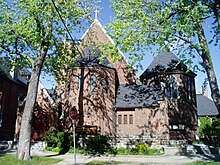St. Thomas's Anglican Church (Toronto)
| St. Thomas's Anglican Church | |
|---|---|

St Thomas Anglican Church
|
|
| Denomination | Anglican |
| Churchmanship | Anglo-Catholic |
| Website | www.stthomas.on.ca |
| History | |
| Founded | 1874 |
| Dedication | Thomas the Apostle |
| Administration | |
| Parish | St Thomas, Huron Street |
| Deanery | Parkdale |
| Diocese | Toronto |
| Province | Ontario |
| Clergy | |
| Rector | Fr. Mark W. Andrews |
| Honorary priest(s) | Fr. W. David Neelands Fr. Ian D. Nichols |
| Laity | |
| Organist(s) | John Tuttle |
St. Thomas's Anglican Church also known as St. Thomas's, Huron Street is a parish of the Anglican Church of Canada located at 383 Huron Street in Toronto, Ontario. It was one of the earliest Anglo-Catholic congregations in Canada. It was established in 1874, moving twice before settling into its present building, adjacent to the Annex on the western edge of the University of Toronto's downtown campus.
The liturgy and music at St. Thomas's make it a "destination" church. Many people who do not live within the boundaries of the Parish attend services.
The church is an Arts and Crafts building designed by architect and parishioner Eden Smith (1858–1949) and was opened January 17, 1893. The building was altered in 1917 to add a baptistry.
The aesthetic theorist and poet T.E. Hulme attended St. Thomas's while living in Toronto briefly in 1906 after leaving Cambridge University. He is an important figure in Modernist literature, influencing, among others, Ezra Pound and T.S. Eliot. The world-famous great English pianist Gerald Moore (1899 – 1987) grew up and obtained most of his music education in Toronto. In his early life he was sub-organist at St. Thomas's.
The church is known for its high standards in music and liturgy, and is nicknamed "Smoky Tom's" for its use of generous quantities of incense. Liturgy at St. Thomas's is more formal and complex than would be encountered in all but a few Canadian Anglican churches today.
St. Thomas’s draws from the English high-church tradition within Anglo-Catholicism, as distinct from the Anglo-Papalist branch, which took its inspiration from contemporary Roman Catholicism. This tradition, as former rector Fr. Roy Hoult explains, sought
...
Wikipedia
